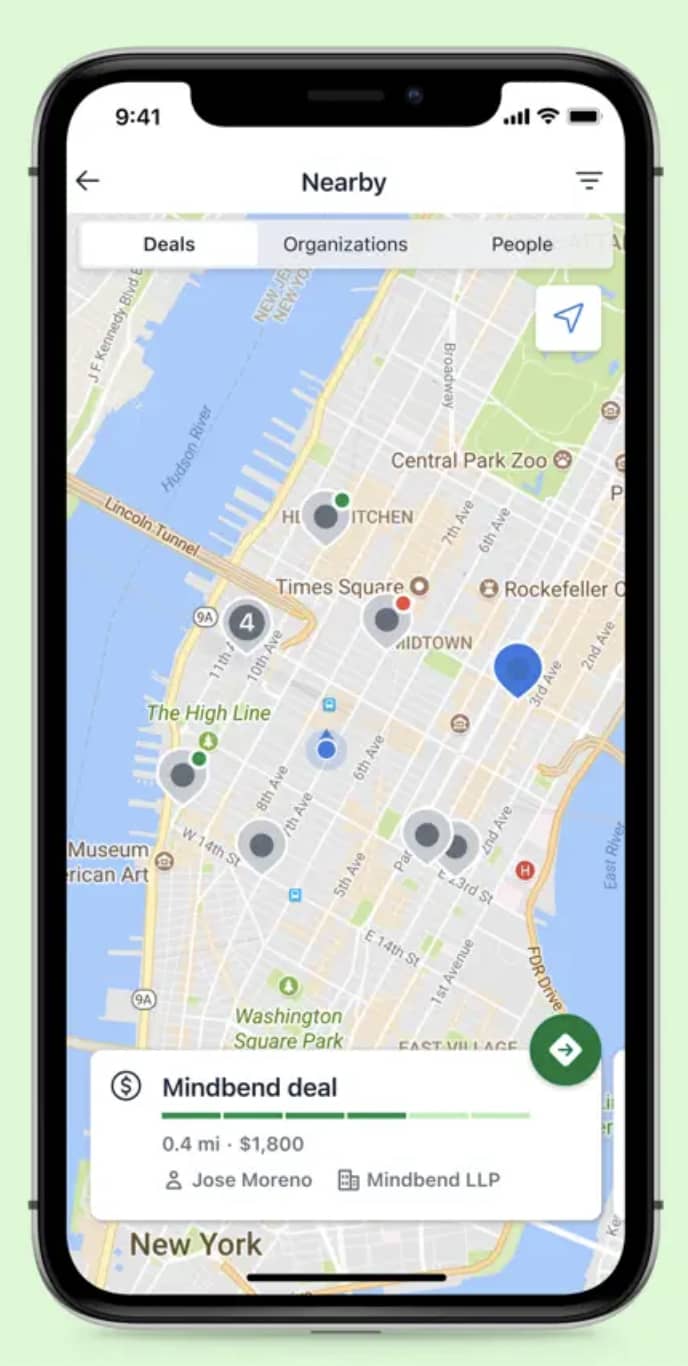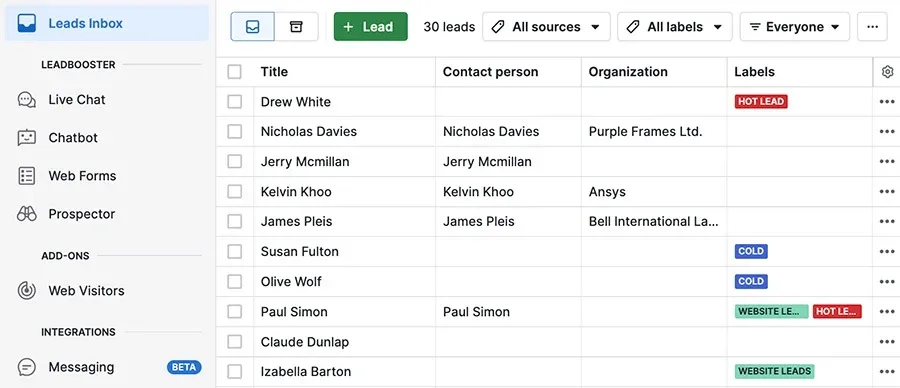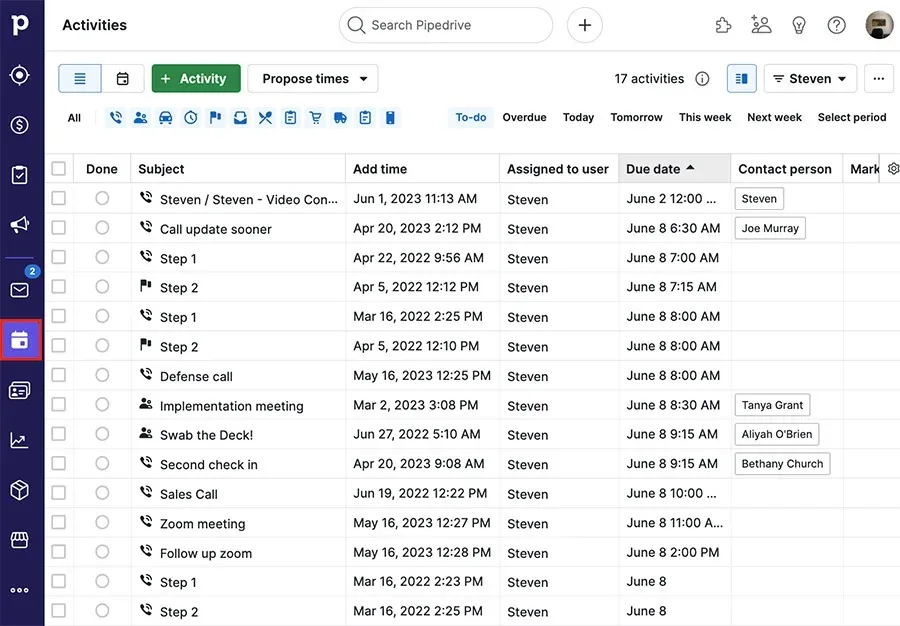Our view at Stack - Pipedrive is a robust CRM platform, offering automation, contact data collection, webhooks, AI-powered sales assistant, email communications, email marketing, and customisable sales pipeline workflows.
Both inside and outside sales are important components of any sales strategy. However, companies don’t always need both for a thriving business.
To be sure you’re not missing out on potential opportunities, it’s crucial to fully understand how both roles work.
In this guide, we’re diving deep into inside sales vs. outside sales and why one might be more valuable for your company’s specific goals over the other. We also cover hiring both types of reps, structuring your sales team and much more.
What is outside sales?
Outside sales involves selling products and services in person through face-to-face meetings. It can happen at industry events, trade shows, the sales prospect’s office, a restaurant or simply going from door to door.
The location depends on what reps are selling, industry norms and each company’s strategy.
You can also refer to outside sales as field sales. Although these types of sales reps do sometimes have an office as their base, they spend most of their time in the field.
Unlike inside sales representatives who may close hundreds of sales without seeing their prospect’s face, the success of outside salespeople depends on their ability to build and maintain in-person relationships.
A solid outside sales strategy can lead to:
-
Deeper customer relationships thanks to the primary focus on building connections
-
Higher close rates (as reps focus on a smaller number of leads and spend more time in person with each)
-
Greater awareness of industry trends and new sales opportunities thanks to more candid insights from face-to-face interactions
-
More motivated sales reps due to higher commissions or compensation plans
Outside sales aims to build trust through the power of in-person interactions, body language and deeper human connection. Reps’ proximity to the client means hiring the right kind of people is crucial (we’ll touch more on that later).
Seal More Deals With Your Free Sales Communication Handbook
Learn to master your sales conversations with this 25 page ebook. Expect expert advice to help you level-up your soft skills and pump up your conversion rates.
What is inside sales?
Inside sales is the process of selling products and services remotely (as opposed to face-to-face). Inside sales professionals use phone calls, cold emails, video conferencing and more to maintain relationships with their leads, prospects and customers.
You can also define inside sales as virtual sales or remote sales. It usually takes place from behind a desk, so inside sales representatives can sell to anyone, regardless of how far away they are.
Thanks to its virtual nature, it’s common for software as a service (SaaS) companies with digital products and business-to-business (B2B) companies that sell to multiple decision-makers to use an inside sales model.
In the 1980s, “inside sales” differentiated telemarketing from high-value phone sales that were typical for B2B and business-to-consumer (B2C) practices.
By the early 2000s, inside sales came to mean sales conducted from an office or fully remotely rather than in the field or territory.
An inside sales strategy offers a lot of efficiencies. For instance:
-
Reps follow a well-defined, strategic sales process
-
Not having to travel for in-person meetings can mean a shorter sales cycle. Reps have more time to focus on selling (instead of meeting admin and travel)
-
With less travel, inside sales reps can quickly switch focus from one sales funnel stage to another.
-
When a lead goes cold, a rep can immediately pick up the next rather than spending time and resources to physically meet with them.
Automated outreach (e.g., outbound emails and social media messages) poses an opportunity to scale. It allows reps to communicate with dozens of leads daily.
Recommended reading

Three top outreach software tools and how to use them
What does an outside sales representative do?
An outside sales job description would start by mentioning a rep will be on the go often. They meet potential customers out in the field or at events (e.g., conferences and trade shows).
Often, an outside representative will have a sales territory where they meet clients in their own offices or places of business. Account managers or account executives usually work as outside reps to build personal connections with customers.
Other opportunities for a sale might be outside of a work setting, such as at a golf course or restaurant. It could also involve visiting businesses in a target market that matches current buyer personas or ideal customer profiles (ICPs).
Unlike inside sales, outside sales reps often set their own schedules (depending on the industry) and work more autonomously. Their working hours may differ from the standard 9 to 5, depending on the types of meetings they arrange.
Like inside sales, outside sales follows set processes and thrives on activity-based selling. On top of standard sales tools (e.g., CRM software and a calendar) and channels (e.g., email, phone calls and text messages), reps also use tools to map their physical sales territories and routes.
For example, here’s what the Nearby feature in Pipedrive’s mobile CRM app looks like for reps on the go:

The technology maps all of a rep’s nearby contacts, making it easier to personalize sales. They may use it to coordinate planned meetings or just drop by when they happen to be in the area.
Outside sales reps invest a lot of time into each lead they choose to meet, especially when there are several decision-makers involved.
Correctly qualifying leads (and breaking up with prospects who aren’t a fit for their offer) helps reps make the most of their time in the field. In other words, they focus on quality deals over quantity.
What does an inside sales representative do?
Inside sales reps work from their home or office, spending most of their day cold calling, emailing or reaching out in various ways to generate new leads for their team.
Since inside salespeople don’t meet with their prospects in person (thanks to remote selling), they need reliable tools to connect with potential customers.
They have to be able to take a cold lead and turn it into a paying customer without leaving their desk. To do so, they need a stable internet connection and a way to conduct phone calls with quality audio.
The channels reps use for inside sales processes are similar to those used by outside sales. However, inside sales teams can typically handle activities in these channels at a much higher volume. Channels include:
-
Phone calls
-
Emails
-
Video conferencing
-
Live chat
-
Text messages
Inside sales reps also need specific soft skills like picking up verbal and audible cues in sales conversations because they usually don’t meet clients face-to-face. Without these types of communication skills, reps will struggle to move their deals forward.
Jaakko Paalanen, former Chief Revenue Officer at Leadfeeder says:
Inside sales also offer a more predictable schedule. Based on conversations, reps can quickly identify their prospect’s position in the sales funnel and plan their daily and weekly activities accordingly.
Let’s say a rep’s goal is to close 10 sales this month. The ideal pipeline might include 200 incoming leads for this period.
The rep knows they qualify about half of all leads, which brings them 100 good leads to work with. If they usually close 10% of all their qualified leads, there’s a good chance they’ll hit their goal.
Understanding these benchmarks and what a qualified lead looks like can help them stay on track to meet sales quotas. If leaders empower reps with CRM software to measure their efforts, they’ll tip the scales in their favor.

The salary of inside and outside sales reps
If you’re building a team of inside or outside sales reps, you want to make sure you’re offering compensation that will attract top performers. If you’re looking for a job in such a team or are already in a similar sales role, you want to make sure you get what you’re worth.
Let’s look at the average salary for sales jobs in several countries (accurate as of April 2024).
Note: Salaries listed below are rep averages. Outside and inside sales executive salaries will be much higher.
Inside sales vs. outside sales salary: United States
-
Inside sales representative salary (US, Glassdoor): $62,990 per year
-
Inside sales representative salary (US, PayScale): $49,795 per year
-
Outside sales representative salary (US, Glassdoor): $85,926 per year
-
Outside sales representative salary (US, PayScale): $55,203 per year
Inside sales vs. outside sales salary: United Kingdom
-
Inside sales representative salary (UK, PayScale): £25,769 per year
-
Outside sales representative salary (UK, PayScale): £25,789 per year
Inside sales vs. outside sales salary: Ireland
Inside sales vs. outside sales salary: Australia
Inside sales vs. outside sales salary: Canada
Inside sales vs. outside sales salary: South Africa
General salary differences between inside and outside sales
Note that salaries depend on the specific country, its standard of living and market fluctuations. These situations call for and value the two types of sales representatives differently.
Consider these differences when hiring for either outside or inside sales roles in specific countries. Use the above numbers as a baseline, noticing that outside sales professionals tend to be paid slightly more than inside reps.
Here’s the case for a higher salary for outside sales representatives:
-
Outside sales reps are likely to have a higher close rate (thanks to fewer leads and deeper relationships with each)
-
Deals closed through outside sales are often larger or higher value than inside sales
-
Field reps often have more years of sales experience
Being out in the field also requires adaptability from a sales rep’s perspective. The more experienced they are, the easier it is to handle any curveballs and unforeseen circumstances.
Outside sales vs. inside sales commissions seem to reflect this, too. For example:
In the US, inside reps get an average of $12,000 yearly commission, while outside reps get an average of $22,560 commission
While benchmarks are helpful, salaries and commissions should reflect the value of each rep’s skillset, talent and the results they create for their team.

The cost and scalability of inside and outside sales
In addition to the salaries associated with hiring inside and outside sales reps, you should also consider commission costs and growth potential for these roles.
The cost and scalability of an inside sales team
With an inside sales team, your budget can go a long way. Reps simply need a computer, a solid internet connection and tools including a CRM system to help them stay on track.
As you add more inside reps to your team, the cost of running your sales operations doesn’t skyrocket. New costs include a new hire’s salary, an additional CRM seat and sales training.
Potential for growth offsets those costs. With a bigger team that operates from your office (or even their own home if they work remotely), you can now reach more prospects and upscale your sales. On top of that, with a great CRM tool like Pipedrive, your inside sales team will be able to:
For instance, Pipedrive’s customizable Leads Inbox can help focus efforts as reps move deals through the pipeline.

This separate inbox can help them track prequalified leads before they become deals. Tools like these can help your inside sales team multiply results at a lower cost, with minimum risk.
The cost and scalability of an outside sales team
Growing your outside sales team will usually cost you more than salaries and CRM seats – it’ll include things like travel, lunch meetings and event tickets. However, depending on your industry, product and stage of your business, the cost might be well worth it.
Your field reps rely on the quality of their in-person meetings. For every new rep, you must ensure you can meet the budget for flights, dinners, meeting rooms, accommodation, a company car and more.
On top of that, you can’t automate face-to-face conversations. Your rep can’t have the same discussion with more than one lead at the same time. These conversations also last longer than a typical phone call or an email exchange.
In other words, an outside sales representative may only be able to manage a single relationship and close one deal at a time. They also spend significantly more time switching (i.e., traveling) between two leads than an inside sales rep does.
However, if you’re selling high-ticket products or services, investing in outside sales reps can yield returns for many years to come. Jaakko Paalanen suggests the following:
Deeper customer relationships are often behind higher customer lifetime value and loyalty.
Steven Benson, the founder and CEO of route-planner app Badger Maps, describes a trick to maximize outside sales performance despite the scalability challenge:
Outside sales can be trickier to scale because of the higher costs of hiring more experienced reps. However, the investment still seems to pay off. Despite the recent recession, our research suggests that companies are still hiring and investing in their businesses.
Within the current recession my company has:
Investing in more in-person customer relationships is a smart approach when you’re aiming for slower, long-term growth. However, inside sales may be a cost-effective initial focus when you need to grow faster.
The sales experience requirements for outside sales vs. inside sales
What should you look for in inside and outside salespeople? Keep in mind that all high-performing sales reps are great communicators driven by understanding their prospects and focused on results.
That said, the way they’ll have to use these sales skills in an inside sales model compared to the outside environment is quite different. Let’s look into both.
Inside sales experience requirements
When reviewing CVs for inside sales representative jobs, here’s what you’ll want to look for and ask about in your interviews:
-
Process-driven selling skills. Inside sales’ well-defined funnel and clear sales activities move deals from one stage to the other, often quickly. A sales rep who can show you how and why a CRM drives their daily and weekly action items is a valuable one.
-
Genuine excitement about working in a team. Unless it’s a remote role, inside sales jobs involve spending 40 hours a week in an office. The more comfortable, driven and energized your reps are around a team, the better their results will be.
-
The ability to communicate clearly in writing and over the phone. Inside reps have a limited window to deliver their message to the decision-maker. Whether sales conversations occur over email, social selling, live chat or web conferencing, reps must articulate their messages well.
-
Readiness for fast-paced selling and openness to change. A shorter sales cycle can mean frequent switching between funnel stages, leads and tools. As the team shifts priorities, reps need to be open to swift changes in quotas or strategies.
Outside sales experience requirements
On the other hand, here’s what to look for when hiring a high-performing field sales rep:
-
A self-starter who enjoys solo work on the go. A great field sales rep will thrive working independently, focusing on one relationship at a time.
-
Efficient time management and appointment setting. Outside reps arrange their own meetings, routes and goals for the day in the field. Look for candidates with confident prospecting skills who optimize their time and energy.
-
Openness to new environments, people and challenges. No two days are the same in outside sales. Every person, meeting and location is unique, so look for a rep who will make the most out of every situation (e.g., a delayed flight or last-minute cancellation).
-
Charisma and confidence building in-person rapport. Look for a candidate who can make their leads feel good after speaking with them in person. Making instant connections should come easy, as well as active listening and reading non-verbal cues, facial expressions and tone of voice.
Inside sales vs. outside sales: key differences between roles
If you’re looking for long-term, large-scale growth and can afford it, outside sales representatives might be the way to go. If you need fast results that fit into a smaller budget, you may need to focus on inside sales only.
Throughout their sales process, both inside and outside sales reps:
-
Establish a personal connection with their leads
-
Listen to their challenges and pain points
-
Present solutions relevant to these pain points
-
Address objections
-
Close deals by asking for business
The difference is that outside sales representatives often combine all these steps during meetings with their prospective clients. Inside sales reps usually split these activities between dozens of email, text and phone call touchpoints.
Thanks to a hands-on process, outside sales naturally result in a longer sales cycle that’s built around standing relationships with clients.
These in-person relationships can’t be scaled or automated. However, by working with fewer leads at once and focusing on each person’s individual needs, outside sales reps are likely to close a higher percentage of deals in their pipeline.
Here’s a high-level look at the key differences between the two types of sales teams:
|
Inside sales |
Outside sales |
|
| Sales conversations | Remote | In person |
| Sales cycle | Shorter | Longer |
| Scalability | Easy | Difficult |
| Close rate | Lower | Higher |
| Average salary (US) | $50,000/year | $55,000/year |
| Average commission (US.) | $12,000/year | $22,560/year |
Different types of sales organizations also choose to prioritize each at different times. Jonathon Ilett, VP of Global Sales at Cognism, details his approach:
Structuring an inside and outside sales team
While the pandemic forced outside sales teams to adapt to inside technologies and processes, companies are now back to business as usual.
However, LinkedIn’s report that 31% of sellers close deals over $500,000 without meeting the buyer face to face indicates that some typically “inside” processes are likely here to stay.
There’s also no one-size-fits-all solution to structuring your sales team; it will always depend on your market, company goals, industry and many other factors.
Here are three popular ways you can approach structuring your team.
1. Separate inside and outside sales reps
In this setup, there’s no real overlap between your inside and field reps. Everyone works on their own leads and each team has separate daily, weekly and monthly quotas.
Sales leaders enable everyone to do their best work without depending on the other team. You can assign leads to inside or outside reps based on company size, which is a typical approach in B2B sales.
For example, small and medium-sized companies may be better leads for the inside sales team. These deals tend to move through the pipeline faster and fit the nature of remote sales processes.
On the other hand, you can hand over large companies (with potentially more complex deals) to field reps who can invest more time into building relationships that require face-to-face interactions.
2. Encourage inside and outside sales teams to work together
In this approach, each group still focuses on its specialty. All reps stick to inside or outside sales but they collaborate and help each other move leads forward and close deals.
For example, your inside team can work with leads located far from your office before outside reps visit them for an in-person sales pitch.
Inside sales reps have refined processes to identify specific pain points and potential objections which can help your field reps prepare – or save them a trip – if the lead turns out to be unqualified.
3. Hire hybrid sales reps who work on both inside and outside sales
You may choose to employ a hybrid sales team that sells from their desk part-time and in the field for the rest.
When they’re in the office, hybrid sales reps make the most of their time by:
-
Keeping an eye on their pipeline and following up promptly
-
Monitoring inbound sales leads and prioritizing reaching out to the hottest ones
-
Automating repetitive sales tasks and streamlining their process to free up time for outside sales
When reps head out, they focus on the leads of highest value. They’re well prepared based on the pain points they uncovered when qualifying these leads and have a plan for approaching them.
Successful hybrid reps also track their activities in the field in the same way they do in the office – with a dependable CRM.
Here’s what a customizable tracking process looks like using Pipedrive:

Reps use it to represent any scheduled action they take on the journey to closing deals (e.g., phone calls, meetings or emails).
Brian Forrester, the co-founder of SEO and digital marketing agency Workshop Digital, describes the company’s hybrid approach to inside and outside sales:
“We don’t need dedicated inside sales reps and we don’t need dedicated outside sales reps, so consolidating the responsibilities allows us to operate a very lean sales team and still hit our sales goals. For our small business, this hybrid model is more cost-effective. Our internal sales are scalable as we close them entirely over the phone or via web conferencing, and we do this for about 80% of our new business prospects.
However, certain key accounts, as well as local businesses near Richmond, VA, require outside sales functions, including more in-depth and personalized strategies and face-to-face meetings. While we aren’t ‘pounding the pavement’ and knocking on doors to generate prospects, some of the prospects do require an outside sales approach. We’ve become more adept at assessing those needs and layering on the right approach over time.”
The tools to empower your inside and outside sales reps
Whichever team structure you decide is right for you, you need tools and sales technology that allow your reps to work at their optimal level and collaborate efficiently.
As Stan Masseueras, former VP of Business Development and Partnerships at Intercom, explains:
“The democratization of productivity and communication tools has been extraordinary over the past five to seven years. It has never been easier and cheaper to sell to, manage and support your customers wherever they are and connect with them at a deeper level
We’ve evolved toward a world where inside sales reps travel to meet customers strategically and field reps are boosting their productivity by making the most out of modern communication solutions.”
Here’s a list of tool suggestions that cover four crucial elements of sales:
-
CRM. With Pipedrive’s sales software, teams can work from a visual sales dashboard that enables everyone to keep track of their work, metrics and goals. (There’s even a mobile CRM for offline use.)
-
Lead generation. LeadBooster enables sales reps to react quickly to the warmest prospects (those who visit key pages on your website) and make the most of their outreach.
-
Sales calls. Reps can streamline call workflows easily with JustCall and Pipedrive’s CRM email tracking and communications feature. It helps them avoid busywork and focus on engaging with customers.
-
Email marketing and automation. Pipedrive’s email marketing software, lets reps design and build customizable templates and layouts to win prospects’ attention, deliver personalized messages and close more deals.
Inside sales vs. outside sales FAQs
- What is the difference between inside and outside sales?
- What’s a field sales CRM?
Final thoughts
Use this guide to identify the budget and skills you need to build a high-performing sales team that fits your current business needs.
If you’re low on budget and want to scale or have a shorter sales cycle, consider hiring inside salespeople. On the other hand, if you sell a product or service that would benefit from face-to-face engagement with prospects, consider hiring a team of well-qualified outside sales representatives.
Perhaps you would benefit from the best of both worlds, with a hybrid sales team able to charm equally over cold calls or with potential clients in person.
The important thing is that you focus on the most valuable goals for your company, choose a sales strategy to support them and track it all with a user-friendly CRM like Pipedrive.
Seal more deals with your free sales communication handbook
Learn to master your sales conversations with this 25-page e-book. Expect expert advice to help you level up your soft skills and boost your conversion rates.
If Pipedrive is of interest and you'd like more information, please do make contact or take a look in more detail here.
Credit: Original article published here.
